The Black Room, The Man They Could Not Hang, The Man with Nine Lives (1935, 1939, 1940)
Directed by: Nick Grinde, Roy William Neil
Written by: Arthur Strawn, George Wallace Sayre, Harold Shumate, Henry Myers, Karl Brown, Leslie T. White
Starring: Boris Karloff, Jo Ann Sayers, Lorna Gray, Marian Marsh, Robert Allen, Robert Wilcox, Roger Pryor
KARLOFF AT COLUMBIA: On Blu-ray 3RD MAY, from EUREKA ENTERTAINMENT
Of course it isn’t intentional, but Eureka Entertainment seem to know more and more what will interest Yours Truly. A few months ago I got to watch and review the six Inner Sanctum films starring Lon Chaney Jnr. And now I get to watch and review the six films made by an even greater old time horror icon – Boris Karloff – at Columbia Studios, which comprise – with one exception – his ‘Mad Doctor’ series!
DISC ONE
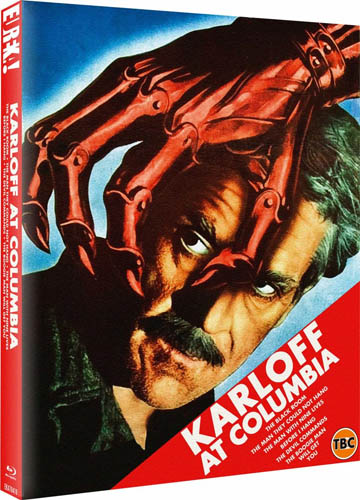
THE BLACK ROOM [1934]
RUNNING TIME: 68 mins
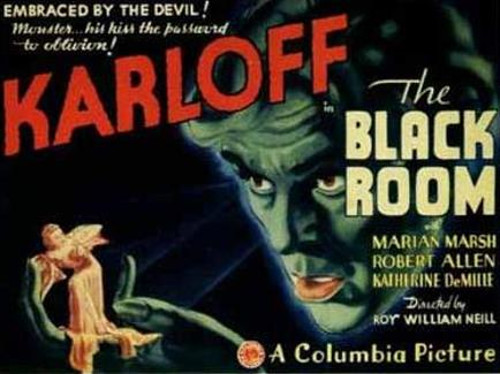
In a Tyrolean castle in the late 18th century, twin sons Gregor and Anton are born to the de Berghmann baronial family. The Baron is concerned: an old family prophecy states that the younger brother shall kill the elder in The Black Room of the castle. 1834; Gregor has become a tyrannical ruler who may be responsible for the disappearances of local women, and is so unpopular that people keep trying to kill him. Then Anton returns, and proves to be the total opposite of his brother. Obsessed with Thea the daughter of his advisor Colonel Hassel, Gregor conjures up a diabolical plan to have her and rid himself of Anton….
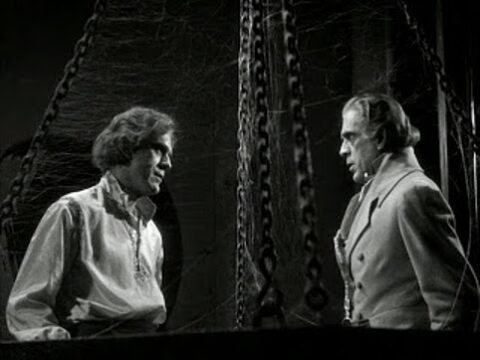
I must have read a bit about The Black Room many years ago, because I distinctly remembering learning that Grahame Greene, the writer who was also a film critic for some time, wrote that Karloff was allowed to act at last. I also remember getting pretty wound up about this, because I felt, and still do, that his performance as the Frankenstein Monster is one of the greatest in cinema. Unfortunately Greene’s comment typified the snobby attitude to horror movies that most critics had at the time, and it’s something that has only seriously changed in the last two or three decades. Some may question whether The Black Room is horror, and there’s no supernatural stuff even though a line of dialogue suggests that this may become the case, but the costume drama is definitely crammed with Gothic tropes, so much so that one gets the impression of a production approached with a very knowing attitude, almost but not quite crossing the line into pastiche. The neat plot concocted by Arthur Strawn and Henry Myers is told at a fast and furious pace throughout its sixty-eight minutes while still allowing for a strong atmosphere to develop in its principal setting, a gloomy castle with a secret passageway and one of those rooms you shouldn’t go into, this one having a oubliette underneath it. And Karloff, who said at the time this was his favourite of the films he’d done up to that time, is simply terrific in his dual role; well, actually, it’s really a triple role, if you think about it. But I’m going go try not to go into detail about that because the surprise plot element that comes along half way through is best left a surprise!
So we’re in that familiar Mittle Europe, with even several familiar faces of the period including Edward van Sloan in a tiny part as a doctor, and two twin babies have been born. “No, don’t toast this birth” says their father, because their family began with the murder by one brother of another in The Black Room, and the time has come around for it to end with one. Anton was born an hour after Gregor, and is the one who will supposedly do the killing, though he’s paralysed in one arm so it doesn’t seem too likely. The Baron has the bright idea of having The Black Room sealed up, then we get some nice transitioning as the twins as children visit their mother’s grave and then their fathers, while we can appreciate a simply gorgeous graveyard set that ranks with the best of those seen in the Universal horror films of the time. As an adult, Gregor is not a kindly Baron, and therefore hated by his subjects. He supposedly kills local women and their bodies disappear, something we soon see see when current girlfriend Mashka, who’s clearly been corrupted by Gregor and ignores her nice village boyfriend, is murdered by him and thrown down the obliette because what Gregor really wants is Thea. Thea has a man, Lt. Lussan, though that won’t stop Gregor who’s devious as well as murderous. Of course the cultured and somewhat fey Anton is his polar opposite, and won’t believe that his brother is so bad. However, Gregor failed to realise that an item of clothing fell off as he was carrying Mashka’s corpse [ a careless mistake], and somebody else who resides in the castle found it. The story races forward without pause, taking in several turns with ease even if we might wish for an extra ten minutes or so, just so that some aspects had been given more time spent on them. The townsfolk storming the castle occurs half way through along with a rather unconvincing plot turn, while the real hero of the climax is a dog, a dog who you’ll be seriously rooting for – I promise, even if you don’t usually like dogs!
While Karloff gets to deliver some surprisingly overt sexual innuendo whilst eating a pair, otherwise the cocktail of murder and madness is very mild in terms of strength. Just a year before, just before the Production Code seriously turned strict, it may have been stronger meat if one thinks of, say, The Black Cat, and Karloff gets to play chess here too. But few other actors could say “she’s a lovely child” and make it seem so lecherous and sinister. He seems to be having a ball playing both brothers, with an attention to detail which is taken even further in his third performance which is immensely clever. I feel that this is one of Karloff’s defining films in terms of his talents and, while for some of the time the two brothers are either not in the same shot or we see one interacting with a double who has his back to the camera, there are three split screen sequences which look virtually seamless even allowing for the obvious vertical line in the middle of the screen; honestly, they’re that good . Elsewhere director Roy William Neill, later to become the main helmer of Universal’s Sherlock Holmes series with eleven out of fourteen installments to his credit, utilises the obvious device of mirrors a fair throughout, sometimes to the point of having shots that we don’t realise are reflections until the camera properly shows us this. Great attention to detail leads to even other scenes, like when Gregor uncurls his hand just before a murder and then the victim curls his hand as he dies. Allen G. Siegler’s cinematography is quite fluid for the time and even uses two rapid zooms to highlight one particular moment. Outside the castle and the village, Christian icons seem to be randomly placed amongst the rocks and the hills, and look rather sinister. Both highly entertaining without a dull moment, and quite artful, The Black Room is almost a major revelation and deserves some revaluation.
Rating: 









‘THE BLACK ROOM’ SPECIAL FEATURES
New Audio Commentary by film historians Kevin Lyons and Jonathan Rigby
Lyons and Rigby have done other tracks together, but I had yet to hear one until now. I was familiar with Rigby though from some special features of Hammer movies, so I was looking forward to hearing his authoritive – but without being dry or pompous – voice here. He actually dominates the track, with Lyons not getting to say as much though his contributions are always worthwhile. and the two have a good rapport. Clearly full of enthusiasm for the film and this kind of film and story, they’re a great choice. We learn that we’re watching credits that were re-done in 1955 for a re-release with the original ones now lost, hear all that Greene review [which is actually rather good], and are told that the dog had been trained on a previous production to snarl whenever the director called action so Neill had to signal this different ways. Very good.
Still Galleries:
– Production Stills
– Artwork and Ephmera
THE MAN THEY COULD NOT HANG [1939]
RUNNING TIME: 64 mins
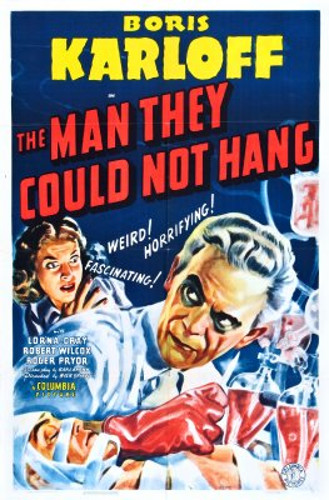
Dr. Henryk Savaard thinks he’s found a way to both bring the dead back to life and extend people’s lives by placing an artificial heart inside a recently deceased person. Medical student Bob Roberts offers his services to him, but before he can bring him back to life, Savaard is betrayed by his volunteer’s girlfriend Betty Crawford and is arrested, convicted, and sentenced to be hung, though just before he’s led away from the court room, he vows revenge on the judge and the jury. And just before his hanging, Savaard’s assistant Lang claims his body and revives him by using his technique….

So here we have the first of the ‘Mad Doctor’ films and if this one is anything to go by then two things are apparent; I’m going to have lots of fun and fear of science will be the main theme. This one seems clearly inspired by Karloff’s earlier The Walking Dead, there are a lot of similarities and variations on things in that movie. While director Nick Grinde and cinematographer Benjamin H. Kline do sneak in a few artful shots here and there including some good high angle work like a look down through a window into a laboratory, this is a straight-forward ‘B’ quickie that overall isn’t as stylish or as interesting as The Black Room, yet which is very compelling. One can be disappointed in the way that high ideals become associated with evil when coming into contact with reality – though this is a Karloff vehicle after all so there was no way that he wasn’t going to become nasty. However, as I was watching the film I did wonder if there would be a series of murders which people would suspect were committed by Dr. Savaard who comes back from the grave but which were actually carried out by his daughter Lorna, so I was pleased when it became apparent that things were not going to go this way. Another surprise was Karloff who wasn’t above winging it when acting in a film that he wasn’t particularly interested in and was just there for the money. Here, I spotted no sign that he felt this material was beneath him, and the way that in the second half he doesn’t move his neck is brilliantly done because it looks natural and doesn’t draw attention it itself, even if he was probably frustrated that his status as a horror star kept him mostly in ‘B’ movies while his talents deserved better. But then Karloff’s popularity has remained over the decades as one of the genre’s icons, and films like this endure and have been released on Hi-Definition while many of the more prestigious movies of the period are rarely seen and thought of.
Karloff’s Dr. Savaard is initially a kind gentleman whose experiments really do seem to be for the benefit of humanity. He makes sure that his test subject [though he says that he’s tried this out on animals and we assume it was successful] is totally sure that he wants to go through with this, even if we’re not sure that Roberts will survive. What I found really interesting was that this fictional and actually rather ridiculous heart-and-lung-machine prop presented an idea that was strictly science fiction at the time but which later basically became reality as “open-heart” surgery which required heart stoppage, then hook-up to a pump, then operating on the repairs, then reconnecting and reviving the patient – exactly the basic theory presented by screenwriters Leslie T. White and George Wallace Sayre here, adapting a story by Karl Brown. However the subject’s girlfriend Betty goes and gets the police, and for a while it’s rather painful seeing Savaard treated in the way that he is as his pleas for being given an hour to bring Roberts back to life are ignored, he’s arrested, tried and condemned to death, but not before Karloff is given not one but two speeches to deliver. We also see him deliver one of his evil grins, though it’s easy to miss, just before he’s hung. What’s different here is that we rather like the fact he has nasty things on his mind. Even though some members of the jury defend him in a scene surprisingly dwelt upon, we hate the majority of them, not to mention the judge and the prosecutor, for what they do. Soon a few of them are found hung, then the rest are invited to a dinner at Savaard’s residence where they’re trapped in a room and told that one of them will die every fifteen minutes, right down to the name.
A whole movie could be made out of the rather Saw-like final act, which does have a somewhat rushed denoument, while if you think about it not everyone acts rationally, but the suspense and the invention level are strong, while we can’t decide whether we’re enjoying these folk, who include Betty, being tormented and even killed, or not – something I’m sure the scriptwriters were aware of. The unfulfilled potential of unusual deaths was hamstrung by censorship restrictions, so in the end the only major flaw of The Man They Could Not Hang is also one of its strengths; its brevity, meaning that some aspects are not developed as much as they could have been. A good example is the character of Janet Savaard. Though well played by Lorna Gray who’s second billed, we don’t really get to know her, nor get much of a sense of her friendship with reporter ‘Scoop’ Foley, who of course has an editor who poopoos his story about suspicious hangings until told of the link between the victims whereupon he tells him to “make it dramatic and make it snappy” in typical newspaper drama fashion. Then there’s one major event which concludes a relationship between two characters which occurs offscreen and is just referred to once. Still, Savaard’s pacing about his cell shown by his shadow is another fine shot that most ‘B’ pictures wouldn’t have bothered with, Grinde, a director I’d never heard of before and who seems to have existed in ‘B’ movie hell [some might day heaven], seems most intent on keeping the pace moving – god these films move and should be shown to anyone who thinks really old movies are dull and boring. A certain conflict about its point of view adds a slight uncomfortableness which is not necessarily a bad thing. The Man They Could Not Hang is a fine little programmer.
Rating: 









‘THE MAN THEY COULD NOT HANG’ SPECIAL FEATURES
Audio Commentary by author Stephen Jones and author/critic Kim Newman
The team of Newman and Jones is so experienced at doing these, yet their tracks always seem fresh. Perhaps one reason for this is their enthusiasm – this one begins with Newman going on about how several Karloff characters had gloomy houses with a bright, modernist room or two and you can feel how much he’s enjoying himself. We learn that it this film was inspired by a true case of a scientist who claimed he brought two dogs back to life but was prevented from trying the same on prisoners, that the showing of executions in films was banned in case people watching wanted them stopped in reality [?], and much about Karloff’s career, with Universal and Warner Bros not knowing what to do with Karloff when horror films temporarily stopped being made in 1936 and the man even appearing in films from Monogram, the cheapest studio, and that he became a familiar TV face so that when many of his films were released to TV in 1955 the ratings went through the roof. As usual, Newman talks a bit more than Jones but it’s another typically lively effort from them.
Still Galleries:
– Production Stills
– Artwork and Ephmera
THE MAN WITH NINE LIVES [1940]
RUNNING TIME: 74 mins
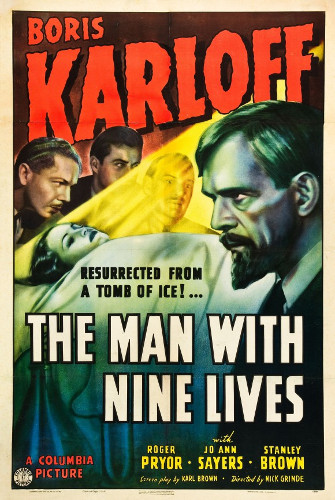
Dr. Tim Mason is working on something called “frozen therapy”, which involves putting patients in suspended animation and freezing them so that bad cells stop growing, then reviving them. He cures a woman by these means, but when the press overstate his achievement, his superior takes the project off his hands. However, he owns a book by a Dr. Leon Kravaal, a pioneer in the field who disappeared ten years ago. So along with his nurse and fiancee Judith Blair, he goes off to Silver Island to locate him, eventually finding him frozen in an ice chamber along with five other men ten years ago were going to arrest him for murder. However, the successful revival of all but one seems to prove Kravaal’s wilder theories….
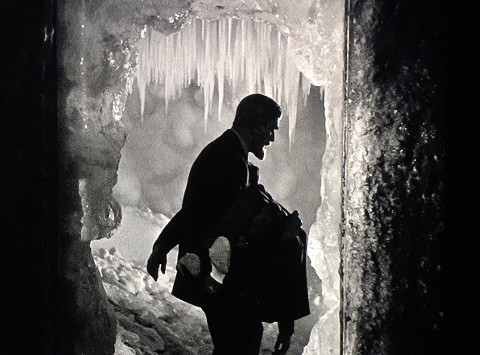
Watching the rather inaccurately titled The Man With Nine Lives, I did wonder if these Mad Doctor films can really be considered as horror. I guess that The Man They Could Not Hang has some horror aspects, but this first of four follow-ups doesn’t really have any at all. So I suppose they ought to really be called science fiction, though Karloff’s presence will always link them to the horror genre. The second isn’t as exciting nor as interesting as first, and has too many moments when somebody describes something that’s just happened, as if it were a radio play. There’s a glaring goof concerning a ladder which I can’t believe wasn’t noticed [I suppose it’s possible that there wasn’t time for reshoots]; when descended we’re told that it has 191 steps, but a few scenes later it seems to be around twelve feet long. And, come to think of it, would it really be possible to go down such a long ladder in high heels? However, the claustrophobic piece, set largely in several dark smallish rooms, does well by zooming in and developing the first act of its predecessor, repeating the idea of a scientist performing a strange experiment which is interrupted with fatal consequences by the police, before then having much of the successive action being of Karloff’s character trying to succeed in doing the same thing. This makes for a rather repetitious and constrained watch, but we want Dr. Kravaal to succeed even when his failures cause people to die, we understand his frustration at not being believed and not given a chance, and therefore we’re still sort of behind him. In a way he’s as much of a hero then Dr. Mason is, and certainly not a total madman. Yet one of the best Mad Doctor scenes of the period has Kravaal pour and mix his “heavily concentrated poisons” while a nice combination of light and shadow brings an extra and rather eerie dimension to what we see.
One of those wonderful newspaper montages we eventually stopped getting in movies begins things as Mason’s demonstration of his supposed cure for cancer is advertised. One can’t help but laugh at the way loads of ice is put on the stomach of the subject – the idea is that, if the body is frozen, bad cells will cease to grow – after which coffee is fed to him introvenously to bring him back to life. The patient is revived successfully but the press exaggerates things, and Mason knows full well that, while he’s found a way to strengthen repair cells and stop malignant cells in their tracks, he still needs to work out how to get rid of them by freezing the body for much longer while still keeping it alive. Temporarily out of a job, he thinks that the long lost Dr Kravaal, a pioneer in the field, may have the answers. The section of he and his fiancee Judith exploring Kravaal’s dilapidated house and secret tunnel takes up quite a bit of time, raising suspicions that there may not be as much to this story, but atmosphere and suspense are created and maintained before we get to the rather convincing ice cavern, which is “the underground arm of a glacier” . It looks much better than similar settings in a few Universal horrors, and finally we meet Karloff after twenty-five minutes, cue for a lengthy flashback of him experimenting on a patient ten years ago where the patient’s nephew called the police who disbelieved Kravaal and wouldn’t let him finish the procedure. They all became frozen for ten years and Kravaal now insists they try to revive the others, though it’s something he’ll soon regret when one of them makes him lose his formula. Still determined to achieve his goal, Kravaal finally starts to lose it and quite frankly can you blame him seeing how unpleasant the others except for Mason and Judith are?
Mason, who sides with Kravaal as much as he can, and Judith, are the only really likable characters here, though it’s a while before Kravaal does anything bad, and even here we can understand why he did it. Karloff manages to still hold back on his usual creepiness to deliver a really sympathetic, restrained and intelligent portrayal of a really nice guy eventually pushed too far. If nothing else, these films [at least so far] really show how darn good an actor Karloff was. Second-billed Roger Pryor as Mason was District Attorney Drake in the previous one and is here promoted from fourth billing to second; he has more personality than your typical young hero of the time though he does fill the ‘assistant’ role for a bit too. Two or three other cast members from before appear too in what seems like will be a pattern for these films. Karl Brown’s screenplay, from a story by Harold Shumate, might seem quaint in its medical aspects though the lowering of body temperature to treat victims of drowning is something that’s often done these days. The not one but two laboratories [this doctor sure was dedicated, setting up one lab through a secret tunnel and another hundred feet under ground, it must have taken him ages] look impressive even though they’re small scale compared to ones seen in Universal and indeed MGM horrors, mixing what look like real pieces of equipment with more fanciful apparatus. But Grinde’s direction lacks the style he sometimes brought to The Man They Could Not Hang and can’t seem to bring much excitement to what’s a somewhat humdrum affair, yet it’s one that still has its points of interest, especially its moral element.
Rating: 









‘THE MAN WITH NINE LIVES’ SPECIAL FEATURES
Audio Commentary by author Stephen Jones and author/critic Kim Newman
The duo’s enthusiasm continues unabated; in fact they seem to like this one more than I did, while Jones gets to say a bit more too. They wonder if Karloff himself had some input into his parts, mention that a still exists of Karloff in frozen makeup and tell us that this and The Man They Could Not Hang lost several minutes in Britain due to its absurd censors, and note that Grinde always has his characters, even minor ones, doing things. They aren’t always scene-specific but I could listen to them talking about Karloff, who they rightly praise very highly, and his arch-rival Bela Lugosi, all day. They probably had notes in front of them, but they don’t sound like it, giving the impression that they could chat about this stuff with no aids for weeks.
Still Galleries:
– Production Stills
– Artwork and Ephmera
Karloff on the Radio
– Inner Sanctum Mysteries [23/10/45] “The Corridors of Doom [29 mins]
How nice of Eureka to include some more of these, previously sampled on their Inner Sanctum Mysteries release a few months ago. The Corridors Of Doom is a quite frightening tale with Karloff as a man who awakes in a hospital bed and comes to think that he could be dead, sometimes sinking into a trance and walking down the corridor of the title. These often ended with revelations that debunked seemingly supernatural happenings, which is okay sometimes but which here is one big cheat. Honestly, it’s really infuriating. Oh well, the rest of it was good, and the banter between bad pun-spouting host Raymond Edward Johnson and the lady getting in mentions of Lipton Tea whenever she can is fun.
– Inner Sanctum Mysteries (6/11/45) “The Wailing Wall” [29 mins]
Edgar Allan Poe’s The Black Cat is the clear inspiration for this tale in which Karloff is bad throughout – no Mad Doctor-style sympathy here. A fire in an old house leads to the discovery of a letter from its owner which tells of how he killed his nagging wife and walled up her corpse with their cat as a witness. The cat doesn’t get it, but somebody else does as Karloff’s character and others hear human-like wailing in the wall containing the body of his wife – or does it? This one plays fair and Karloff’s narration really has that tormented Poe spirit.
DISC ONE SPECIAL FEATURES
Limited Edition O-Card slipcase [3000 copies]
All three films presented in 1080p
I don’t think that these are new restorations; the publicity would surely have said otherwise. But they generally look decent, with even grain management, clear detail and mostly deep blacks though the occasional bit of bleeding occurs. There are some lines that quickly come and go, but the only irritant is when the final reel of The Man They Could Not Hang is in noticeably poorer quality than the rest of the film; blurry and fluctuating in density. I assume that this was also the case with the DVDs, and that this section was badly damaged.
Optional English SDH subtitles
A LIMITED EDITION collector’s booklet featuring writing on all six films by Karloff expert Stephen Jacobs (author of Boris Karloff: More Than a Monster); film critic and author Jon Towlson; and film scholar Craig Ian Mann [3000 copies]
Review of Disc 2 up in a short while!


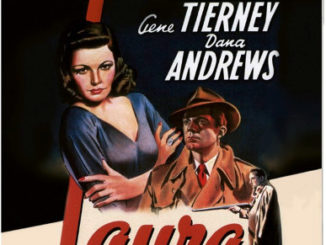
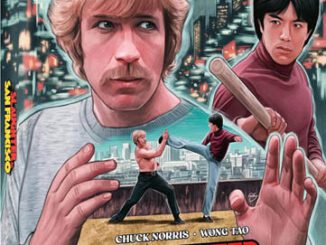
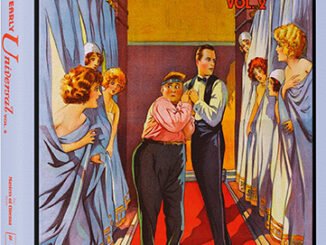
Be the first to comment